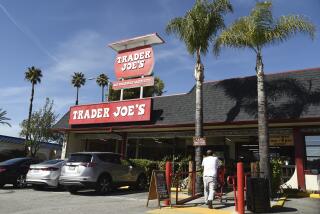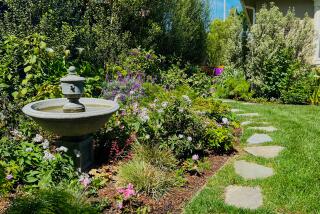Market Watch: Exotic, sweet and rare summer fruits
The U.S. Department of Agriculture has proclaimed Aug. 7 to 13 to be National Farmers Market Week. In Southern California, unlike most of the rest of the country, we enjoy exciting offerings of local produce year-round. But even here, high summer gives us the greatest abundance and diversity.
Stone fruit and heirloom tomatoes, our markets’ summer glory, are at their peak, while grapes and apples are coming on. The busier markets are often so crowded that it can be difficult to make one’s way through them.
The most eye-catchingly exotic fruit in markets now is the pitahaya, or dragon fruit, a large, flaming pink, spineless cactus pear native to tropical America and widely cultivated in Southeast Asia. A decade ago it was virtually unknown here, but it has since been planted on several hundred acres in Florida and on a smaller scale in California; in addition, considerable quantities of irradiated pitahaya are imported from Vietnam, and the USDA just proposed allowing the fruit to be brought in from Mexico.
Pedro Gallardo, who grows pitahaya in conjunction with Henri Gerwig, a farmer in Fallbrook, has made this crop his specialty and sets out an enticing display at many markets, including Long Beach Marina, Brentwood, Santa Monica, Torrance, Pacific Palisades and Laguna Beach.
At the farm they’ve got 30 varieties and are experimenting with hybridizing new ones, trying to come up with the best combination of flavor, appearance and production. The harvest, which just started, runs for several months, although production, abundant now, can be erratic, says Gallardo. The flavor, sweet and mild, is pleasant but not as spectacular as the appearance; if it were, pitahaya would be illegal.
For those with a particular interest in this intriguing fruit, there will be a pitahaya festival and field day, including a variety tasting, at the University of California’s South Coast Research and Extension Center in Irvine on Aug. 27; registration is $40, and reservations are necessary and go fast.
A crabby beauty
For sheer beauty, no fruit in the markets matches the Transcendent crab apple, which has delicate, light golden skin with the fine texture and translucence of alabaster, flushed with red, giving it the luminous appearance of fruit in a Dutch 17th century still-life painting. It’s a crab apple of unknown origin that first showed up in the Eastern U.S. in the mid-19th century and in California a century ago. The yellow flesh, tart and slightly astringent but very flavorful, is good for nibbling, for making jelly and for cooking with rich meats like duck and pork. Bill and Barbara Spencer of Windrose Farm offer this alluring fruit at the Wednesday Santa Monica market.
The harvest of Gala apples, small, sweet and eminently snackable, started a couple of weeks ago in the northern San Joaquin Valley and has just begun in coastal valley districts. Fair Hills Apple Farm of Paso Robles brings very good Galas to two dozen local markets, and Michael Cirone of San Luis Obispo offers them at Santa Monica Wednesday.
Cirone also has Pink Pearl, which has a similar pale translucent skin, greenish or cream colored, flushed with pink in the riper specimens, which hints at the real surprise on the inside: bright pink flesh. It’s a true California original (one of our few significant indigenous apples, along with Skinner’s Seedling, Hauer Pippin and Sierra Beauty), introduced in 1944 by the great plant breeder Albert Etter, who selected it from seedlings of Surprise, an old English pink-fleshed apple that probably derived from the wilds of Central Asia. Pink Pearl is not just for looks. It’s crisp, fine-grained and intensely flavorful, making it a natural for colorful applesauce, pies and sorbet.
Ain’t it Le Grand
Supermarket buyers are aware that farmers markets have taken a bite out of their produce sales, and the most progressive among them are striving to boost their pizazz by offering top-quality local items. A case in point is Le Grand nectarine, the father of modern yellow nectarine varieties and still the most flavorful. It’s a clingstone with dense, deep orange flesh, startlingly high in acid but with the high sugar to stand up to it and intense aromatics, giving it a powerhouse punch that thoroughly outclasses most recent varieties.
Although nectarines are merely fuzzless peaches and have been around for millenniums, the gene that controls the trait for smooth or fuzzy skin was also linked to other characteristics: Nectarines had an intense wild tang but also tended to be small, bruise-prone and susceptible to disease, with slightly fibrous flesh, making their commercial cultivation much rarer than that of peaches.
Fred Anderson, a stone fruit breeder in Le Grand, southeast of Merced, revolutionized the prospects for nectarines with his Le Grand variety, selected in 1936 and introduced in 1942. It’s a second-generation hybrid of J.H. Hale, a standard yellow peach from a century ago, and Quetta, a yellow nectarine imported by the USDA in 1906 from what is now Pakistan. It was large, firm and productive compared with previous nectarines, and within a decade it was widely planted in the San Joaquin Valley — so much so that it acquired another name, the Pot of Gold.
Anderson and later breeders continued making crosses and came up with many fine new varieties, like Late Le Grand, which may be even better (Art Lange of Honey Crisp will have it at Santa Monica and Beverly Hills in a couple of weeks), but ultimately their selection for commercial characteristics denatured the nectarine and gave us the big, bland red rocks that prevail today.
When David Mas Masumoto, the renowned farmer and author, was growing up in the 1950s, his family had a block of Le Grand, which was later grubbed as “improved” nectarines came along. But Masumoto remained haunted by the intense flavor of the fruit — “It’s my ideal nectarine,” he says — and replanted 2.5 acres.
Generally the crop has been sold in the San Francisco Bay Area, but last Saturday Karen Beverlin of FreshPoint, a purveyor with a keen nose for fine fruit, visited the Masumoto Farm to harvest an Elberta peach tree that she, like a number of fruit aficionados, had “adopted.” This year, for the first time, Mas also allowed the public to adopt a Le Grand nectarine tree, and when Beverlin tasted the fruit, she jumped up and down like a woman possessed, despite the 100-degree heat.
She arranged for a shipment of a few dozen boxes of this historic fruit to arrive at the Venice Whole Foods store today, where it will likely sell out before the end of the weekend. She also sent a few boxes to Sweet Rose Creamery in Brentwood, where Shiho Yoshikawa will be offering Le Grand nectarine sorbet this weekend. Fruit lovers, it doesn’t get much better than this.
More to Read
Eat your way across L.A.
Get our weekly Tasting Notes newsletter for reviews, news and more.
You may occasionally receive promotional content from the Los Angeles Times.






